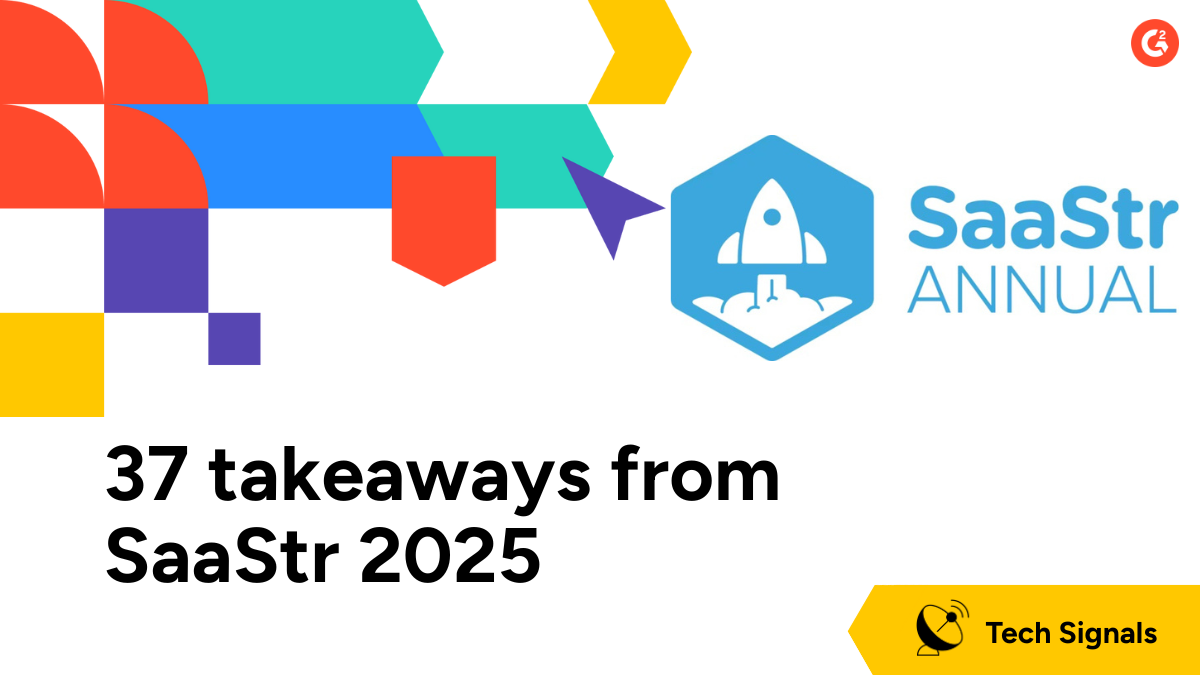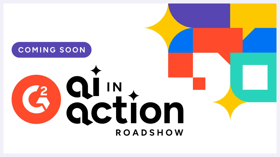May 21, 2025
 by Kamaljeet Kalsi / May 21, 2025
by Kamaljeet Kalsi / May 21, 2025

Four out of five software buyers use LLMs to research products, SaaS companies are facing valuation challenges, and your board wants answers even faster.
A lot went down at the SaaStr Annual + AI Summit 2025 across 200+ tactical sessions from over 300 industry-leading speakers, as well as C-suite summits. If you missed it (or even if you didn’t!), these handpicked hot takes will give you a direct line to the strategies shaping SaaS at scale.
Whether you're navigating pipeline pressure or exploring the next phase of AI integration — dig in and cut through the noise in SaaS to help you answer tough questions at the table.
CMOs are transforming from brand stewards to business strategists. They are expected to drive measurable business outcomes, integrate AI across the stack without disrupting workflows, and lead cross-functional alignment on governance and innovation.
There’s a clear shift from experimentation to AI optimization, enablement, and accountability, all under increasing board and CEO scrutiny.
1. AI is replacing entire layers of the marketing contractor ecosystem. SaaStr’s marketing spend on Upwork dropped from $188K in 2023 to $0 in 2025, replaced almost entirely by $200 worth of AI tools.
2. The AI stack is the new marketing budget question. “What’s your AI stack?” has overtaken “What’s your marketing budget?” as the #1 question among marketing leaders.
3. Holding vendors accountable for AI capabilities is now table stakes. CMOs are less focused on adding tools and more focused on demanding AI-driven efficiency from existing vendors.
4. AI is driving real-time buyer insights and go-to-market (GTM) alignment. CMOs are building AI agents modeled on buyer personas to simulate responses and rapidly validate messaging, content, and GTM strategy.
5. In highly regulated industries, hallucination risk shapes AI adoption. CMOs in legal tech and cybersecurity must prioritize accuracy and compliance, using LLMs for enablement and competitive intel, not just content generation.
6. About 30 minutes a day in an LLM can transform your GTM velocity. Allocating dedicated time for experimentation yields rapid breakthroughs, from sales enablement to content creation to market messaging.
7. AI fluency is now a leadership imperative. Without foundational AI training across teams, even the best tools won’t deliver ROI. Leaders must drive education and culture change, not just tool adoption.
8. Data quality is your AI strategy’s make-or-break factor. AI won’t fix broken data. Structured, well-maintained internal and external data is the bedrock for scaling AI personalization, insights, and automation.
9. AI agents are reshaping org charts. Forward-thinking teams are already operating with AI agents as “virtual team members,” offloading executional tasks and freeing humans to focus on creativity, strategy, and innovation.
10. The shift from “try everything” to “prove impact fast.” Initial AI exploration has shifted to cautious, controlled integration focused on ROI and compliance.
11. Marketing is no longer serving the business (it’s leading it). CMOs are aligning marketing with all 27 steps of the buyer journey and speaking the CEO’s language, pipeline, and results.
12. AI is a forcing function for cross-functional collaboration. It’s breaking down silos between marketing, security, legal, and IT, especially in highly regulated or security-led environments.
13. The hype is over — now comes the education and recalibration. Boards expect 10x ROI, but CMOs must temper expectations and build maturity incrementally.
14. Short-term cycles are killing long-term strategy. Tech and buying cycles have compressed from years to quarters. This volatility makes long-term planning difficult, requiring CMOs to play offense and defense simultaneously. To remain viable, leaders must rethink their entire GTM structure, from ICP to messaging to team design.
15. Disrupt yourself, or someone else will. AI is not just a tool; it’s a tectonic shift. If your company isn’t “AI-first,” it will be disrupted. CMOs must lead scenario planning for AI disruption and explore monetization, pricing, and product strategies that future-proof the business.
“If you’re not asking how to disrupt yourself, someone else is already doing it for you.”
Sydney Sloan
CMO of G2
16. Outbound and content as we know them are dying. Channels like cold outbound and SEO-driven content are becoming less effective as AI answers queries directly. Hybrid models: AI + human are the short-term fix, but longer-term trust-based channels (brand, PR, social proof) are resurging as durable strategies.
17. We’re marketing to the wrong audience. As LLMs (e.g., ChatGPT) increasingly make or influence buying decisions, marketing must shift from solely targeting humans to “training” the AI. If your campaigns don't influence AI models, you become invisible to the modern buyer.
“We are marketing to the wrong agent. We’re still targeting humans, but AI is making the buying decisions.”
Guillaume "𝑮" Cabane
Co-founder of Hypergrowth Partners
As a CMO, you aren’t just a marketing leader; you’re now an AI transformation leader under broad scrutiny. Time to treat AI like a business system, not just a shiny tool.
The era of selling tools is over. The enterprise software model is fundamentally shifting from static tools that require human operators to dynamic platforms embedded with digital labor. Leaders like Aaron Levie, CEO at Box, and SaaStr CEO and Founder Jason Lemkin have some hard-hitting reality checks.
18. AI agents aren't just enhancing user experience. They are redefining the labor model by automating knowledge work at scale, unlocking entirely new addressable markets.
19. AI agents will increasingly deliver outcomes, not just capabilities. They are forcing a rethink in pricing, GTM, and customer success strategies. Enterprises won’t buy software to support internal teams — they’ll hire software embedded with its own digital workforce.
“What an interesting time to be in software … It’s no longer just about selling tools. We’re bringing the process itself via digital labor to the organization.”
Aaron Levie
CEO of Box
20. The AI adoption curve is exponentially faster than cloud. Unlike the cloud transformation, which unfolded over a decade, the AI shift is happening in under two years. Enterprises that don't act now risk losing relevance or even their market position within 24 months.
21. New talent will force a workflow revolution. The incoming generation of workers raised on AI tools won’t accept outdated, slow processes. They’ll ask, “Why are we doing this manually when the model already has the answer?”
AI is collapsing GTM timelines and wiping out manual workflows. Sales and marketing must co-own enablement, experimentation, and tech fluency. Alliances will win you business outcomes.

Join industry leaders at G2's free AI in Action Roadshow for actionable insights and proven strategies to reimagine your funnel. Register now
G2 CMO Sydney Sloan and VP of Research Insights Tim Sanders debuted the 2025 G2 Buyer Behavior Report, which is a mind map of how your customers are finding, shortlisting, and buying software.
22. AI is disrupting SaaS GTM fundamentals faster than expected. “The best practices in 2024 will likely be the worst practices in 2026.” Generative AI isn't just part of the buyer journey; it's driving it from discovery to decision. Traditional SEO, vendor websites, and peer recommendations are rapidly losing ground to LLM-driven, one-shot shortlist creation.
23. LLMs are now the front door to B2B buying, not Google. Four in five B2B buyers now start their research with a generative AI tool, not a search engine. This shift is most pronounced in enterprises, where efficiency demands are highest.
24. Shortlists are being generated by prompts, not processes. Buyers are skipping multi-step evaluations in favor of asking chatbots for their top three vendor picks. If your brand doesn’t surface in AI results, you’re already losing the deal.
25. A new data hierarchy is emerging, and GenAI is on top. First-party (your site) is now the weakest signal. GenAI outputs and software review sites (like G2) dominate the signals that shape decisions.
Source: G2 Buyer Behavior Report 2025
Your ICP doesn’t act like it used to. Get your G2 game on. You’re no longer pitching to the CMO; you’re pitching to ChatGPT or an AI agent that is surfacing community-driven content. Focus on building clean data, fast feedback loops, persona-based agents, review strategies, and GTM models that adapt in real time.
Source: G2 Buyer Behavior Report 2025
Source: SaaStr
CAC is rising, churn is costly, and SaaS growth is slowing. But AI isn’t just helping teams scale — it’s replacing them. From GTM strategies to retention playbooks, Firebolt’s President Hemanth Vedagarbha shows how AI-first organizations are driving growth and rewriting the rules of SaaS in 2025
26. AI-led growth is replacing product-led and sales-led models. The traditional GTM motions are breaking down under the weight of rising CAC, churn, and slowing SaaS growth. The next growth engine is AI-first, specifically agentic AI driving everything from lead generation to customer success.
27. Your buyer isn’t human anymore, and your seller won’t be either. Buying decisions are increasingly made by AI agents evaluating your pitch before it ever reaches a human. If your GTM strategy still relies on cold calls and human SDRs, you’re quickly falling behind.
“If your buyer isn’t human, neither is your seller. Gone are the days you’re building a pitch for a CMO. You’re pitching to ChatGPT.”
Hemanth Vedagarbha
President of Firebolt
If your content isn’t training LLMs, you’re invisible. Future-proof and optimize for AI as much as you do for people. Building AI into your products for the right reasons will fetch you big bucks from software buyers. Fail to do so and churn will continue.


Source: G2 Buyer Behavior Report 2025
What once took years now takes months, and marketers are rethinking everything from channel strategy to team structure just to keep up. Guillaume "𝑮" Cabane, former Ramp CMO and currently co-founder of Hypergrowth Partners, dissects the state of marketing in 2025.
30. AI has collapsed the marketing innovation cycle. What used to be 2–3 year technology and tactic cycles are now quarterly. This speed is breaking traditional marketing models, from tech buying to team design.
31. Choice paralysis is the new norm. CMOs face impossible tech-buying decisions: legacy vendors are too slow; startups are too volatile. Whatever you choose today may be obsolete next quarter.
32. AI is killing channels, not just tactics. Over-automation (e.g., mass AI-generated outbound emails) is creating channel fatigue and trust erosion. Email and SEO aren't just saturated — they're becoming unusable.
33. Fully automated GTM workflows don’t win — hybrid does. The top-performing teams use human-in-the-loop systems: AI scrapes and scores data; humans (e.g., SDRs) craft high-volume, micro-personalized campaigns. Hybrid outperforms pure automation and pure human execution.
34. Speed and modularity are strategy, not ops. Companies like Ramp run 200+ experiments per quarter, with orgs split between growth (execution + automation + product) and marketing (brand + strategy). This architectural agility is essential in a post-LLM world.
Marketing teams must prioritize modularity, AI fluency, and hybrid workflows. Brand-led strategies are resurging as AI noise rises.
AI is reshaping what qualifies as a strategic enterprise asset. The ability to turn vast, legacy data into business value via AI agents is quickly becoming a defining competitive edge.
35. Proprietary, perfect data is the new moat (if you can activate it). Winners are building internal data systems to seed AI workflows. Think structured call data, scraped market signals, and first-party insights powering both content and outbound at scale.
36. Moats are fragile in the AI era. AI isn’t just strengthening incumbents, it’s also democratizing capabilities. A thousand AI-powered startups can now challenge enterprise software giants by offering context-aware, data-connected, conversational interfaces.
37. Open ecosystems are the sticky moats of the future. AI-connected environments (MCPs, APIs) don’t erode moats — they reinforce them by embedding your product into more workflows and increasing the value of your data flywheel.
Defensibility comes from clean data, proprietary insight, and adaptive organizations that can harness their moats. If you’re relying on old tech or channels from 2024, you’re building on sand.
We’re sure that you’re overwhelmed. After all, this is three days' worth of insights packed into one good read.
How about starting with this checklist for now? Bookmark this article and come back for specifics later.
It’s time to rewire your organization. Start with AI scenario planning, role-specific education, and realigning your GTM engine to survive quarterly disruption.
AI is everywhere and ‘Always Included’, influencing the world, your customer, and your product inside-out. If your buyer is a bot, what’s your GTM strategy? Stay ahead of the curve with G2’s industry-leading coverage. Subscribe to the G2 Tea newsletter today.
Edited by Jigmee Bhutia
Kamaljeet Kalsi is Sr. Editorial Content Specialist at G2. She brings 9 years of content creation, publishing, and marketing expertise to G2’s TechSignals and Industry Insights columns. She loves a good conversation around digital marketing, leadership, strategy, analytics, humanity, and animals. As an avid tea drinker, she believes ‘Chai-tea-latte’ is not an actual beverage and advocates for the same. When she is not busy creating content, you will find her contemplating life and listening to John Mayer.
Brand is having a glow-up, and AI is the glam team behind it.
 by Kamaljeet Kalsi
by Kamaljeet Kalsi
For years, the early stages of B2B software evaluation followed a familiar pattern.
 by Sidharth Yadav
by Sidharth Yadav
We’ve been tracking the rise of AI search and predicting its impact on the tech landscape...
 by Kamaljeet Kalsi
by Kamaljeet Kalsi
Brand is having a glow-up, and AI is the glam team behind it.
 by Kamaljeet Kalsi
by Kamaljeet Kalsi
For years, the early stages of B2B software evaluation followed a familiar pattern.
 by Sidharth Yadav
by Sidharth Yadav


